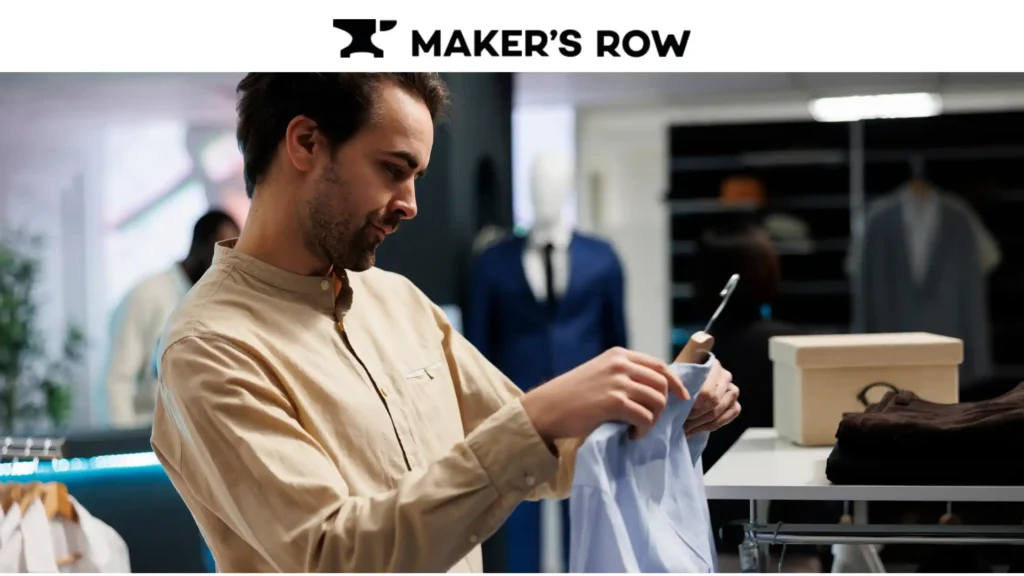Wearable technology is the next big thing in the fashion industry; we can already see it changing the fashion clothing production landscape and its use. When combined with digital innovation, textile design, and manufacturing techniques, wearable technology continues to emerge as a crucial aspect of innovative concepts in the fashion industry. From embedded sensors to fabrics that keep track of fitness and health, fashion tech and apparel are creating a new terrain for manufacturers.
Maker’s Row has a curated network of verified manufacturers that will help your apparel brand connect with wearable tech manufacturing companies; this makes it easier for companies to create the necessary products for the market and innovate further.
Book A Demo! Save on Annual Plans!
What is Wearable Technology?
Wearable technology products are any electronic technology or sub-assembly comfortably worn on the body as part of a garment, accessory, or ornament. From simple activity monitors and wristwatches, wearable technology has developed into the heights of fashion in the last two to three years. This has been made possible by the enhancement of material science, microelectronics, and data integration, whereby a garment can as well be more of a tool than an art.
The Evolution of Fashion Tech
The fashion industry previously focused mainly on aesthetics and textures, but it has now started incorporating wearable technology into clothes as part of apparel innovation trends to keep up with the times. This has made fashion tech more prevalent, and now technology improves not only the design but also the functionality of the clothes. Fashion designers have now been presented with the dilemma of combining design with the extra utilities that wearable tech brings into the picture.
The use of wearable technology in the apparel manufacturing process involves all the stages, beginning with designing. Advanced technology like computer programs and 3D printing has brought drastic changes in prototyping and sampling since designers are able to see where the wearable tech components fit on the fabric. Conductive or energy-storing materials that make clothes intelligent are referred to as smart textiles. With the growing popularity of these textiles, the differentiation between conventional clothing and technological integration has become uncertain.

Wearable Technology for Apparel Manufacturing and its Applicable Use
1. Health Monitoring Garments
Health monitoring is one of the most popular uses of wearable tech clothing. If we look into the apparel innovation trends, we can easily notice an increasing desire for smart clothing that monitors physical health parameters. For instance, athletic wear that has the capability of sensing or measuring the rate of heartbeat and blood pressure, not to mention water intake. These garments collect the data on a smartphone or cloud application so they can be used for personal and medical purposes.
This development is changing the fashion tech sector, bringing a change in the apparel innovation trends. Specialized clothing manufacturers and retailers supplying athletic wear have begun adding wearable technology during the selection of fabrics and manufacturing the relevant textiles to be compatible with technological accessories. This integration can only be successfully done with a considerable understanding of fashion tech and IT, and hence fashion designers incorporating technology engineers.
2. Sustainability Through Wearable Technology
Sustainability is now an important trend in the contemporary fashion industry. Through wearable technology, there has been a chance to advance sustainable innovation in apparel. Some examples of smart tech could be clothes that automatically change their temperature, thereby eliminating the need to wear many clothes at any one time. It also reduces material usage, thereby affording garments a longer shelf life, which is good for sustainable development. Other sustainable apparel innovation trends include clothing that can notify the owner that it wants to be mended.
Since designers can connect sensors to the manufacturing of new clothing, people will be warned when some component is already damaged and do not need to replace the whole dress. This forms part of the attempts to achieve reduced environmental impact on the fashion industry while at the same time improving consumer satisfaction.
3. The Use of Wearable Tech for Improving Performance
One of the most promising domains of wearable technology at the moment is performance-enhancing garments. Fashion technology has manifested changes in professional sportswear and casual wear that help enhance body performance. Specific examples include clothing used to deliver resistance training, posture correction, and post-workout muscle support with compression wear.
To manufacturers, this means an additional consideration where a new layer of control is introduced in the manufacturing line. In order to adapt wearable technology and keep up with the apparel innovation trends, apparel factories should not only update their employees’ technique and skills, but fashion tech can only be made from fabrics that have stretchable, breathable, and strong muscularity to hold the embedded technologies. acquire new technologies and exclusive lines. Also, fashion tech can only be made from stretchable, breathable, and strong muscular fabrics to hold the embedded technologies.
Challenges in Integrating Wearable Technology
However, when it comes to incorporating wearable technology within apparel production, it is not exempt from some difficulties. First, the regular fashion sector could be unaware of the implementation of the technology necessary for creating clothing. Indeed, fashion designers are currently expected to directly work with engineers and technologists, and this will impact the current systems.
Second, the cost of making wearable technology remains higher than the manufacturing cost of traditional apparel. One of the issues in utilizing smart textiles and electronic components is that some of the components are procured from niche markets; their costs may be relatively high for other manufacturers. To meet the increasing demand for fashion tech in the international market, there is a need for increased investment in the equipment production line.
Thirdly, consumers have durability concerns too. Even though wearable technology is a new exciting development, customers are demanding that their clothes are durable and can endure day-to-day wear and tear. Fashion processors today have to make sure that the sensors placed within the garments or the conductive material do not degrade when washed repeatedly or when exposed to an external environment. The parameters like testing and quality control become more or less parts of the manufacturing process.

The Future of Fashion Tech
There is a wide expanse of potential for wearable technology in apparel manufacturing in the future. This technology giant gives consumers what they have never experienced, and as technology advances, more fashion brands will add wearable devices to their existing clothing lines. From the analysis of apparel innovation trends, smart clothing will be the next thing to wear in our closets, which adds benefit.
Smart fashion accessories are a particular segment that can enjoy robust growth in the near future. Products like bags, shoes, and belts that include advanced innovation are already on the radar of fashion designer brands. These accessories can serve different purposes, for instance, being used to charge other devices, count steps, and even track location. The next generation of fashion technologies will be even more customizable, in which a user has the option to determine most of the implementational aspects of his/her clothing’s technology.
Also, the aspects of AI and machine learning in fashion tech would pose a key feature for wearable technology. Smart clothing, which is clothes enhanced with artificial intelligence, can adapt to a person and their daily activities due to the circulated data that is utilized in altering the comfort, performance, and health considering features of the garments. Another area for AI to be incorporated with wearable technology is towards having clothes learn and be able to provide predictive principles to be able to understand changes in its user’s environment or health.
Where can Maker’s Row be of assistance?
If you’re a brand searching for wearable tech manufacturers, then Maker’s Row is the best platform for you. Gain access to recommended vendors and resources about manufacturing processes, and liaise between designers and engineering technology talent.
There are options for prototyping, gaining access to the supply chain for technology components, as well as getting accurate matching services catering to various requirements. Maker’s Row also promotes growth in partnerships, thereby allowing brands to quickly work together and effectively add wearable tech to their clothing lines. To get better insights into the above-mentioned resources;
Conclusion
Smart clothing is the new frontier in apparel design and development and opens exciting new directions in fashion design. When fashion tech is combined with conventional design thinking, the apparel producers design beyond the conventional look and style, with functionality, sustainability, and performance added to the fabric. In spite of the difficulties that can be seen in the integration of wearable technology, for instance, the cost of manufacturing and the wear to which the devices often succumb, the future for these types of clothes is looking bright. As wearable devices evolve to be smarter and more affordable, we can further predict that tech wearables will reinvent fashion in the future.
In conclusion, wearable technology is not some hype but a push that will define the apparel manufacturing industry more in the future. Fashion tech is bringing many new ideas and can redefine what clothing can do, thus making a wardrobe as smart as it looks. From health awareness to the performance era or going green, wearable technology manifests itself as the new frontier of fashion and its possibilities.
Read More…